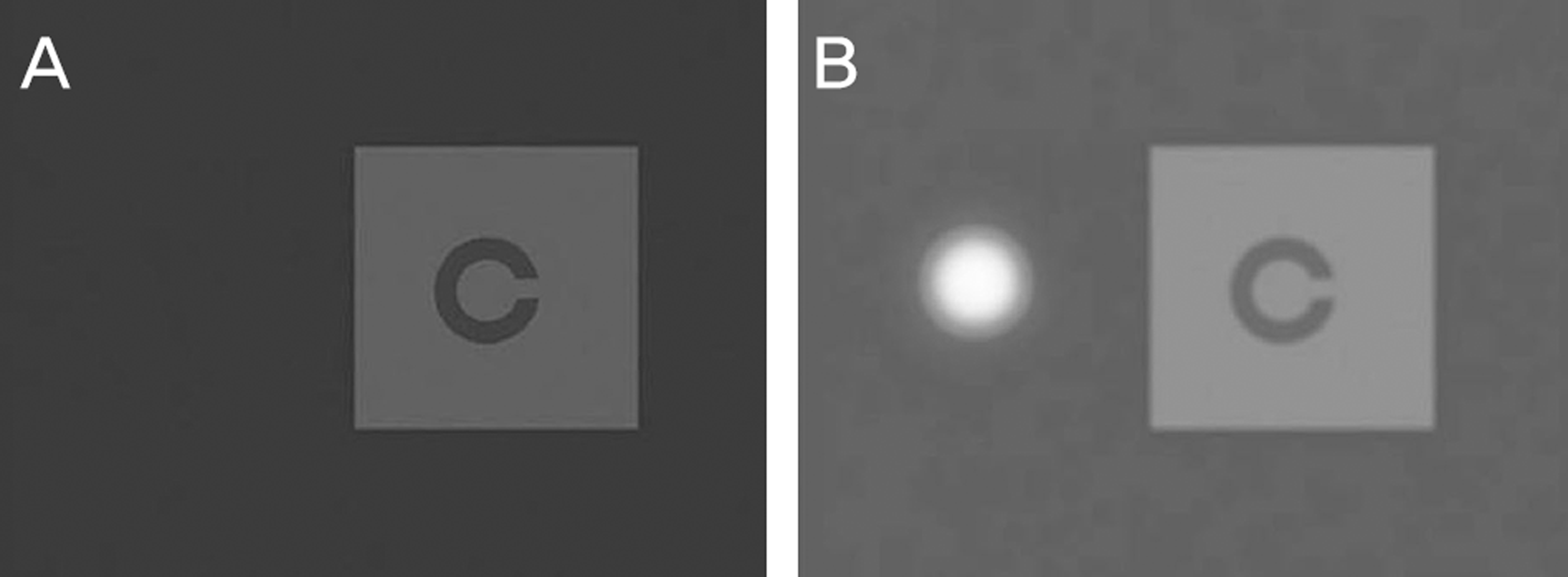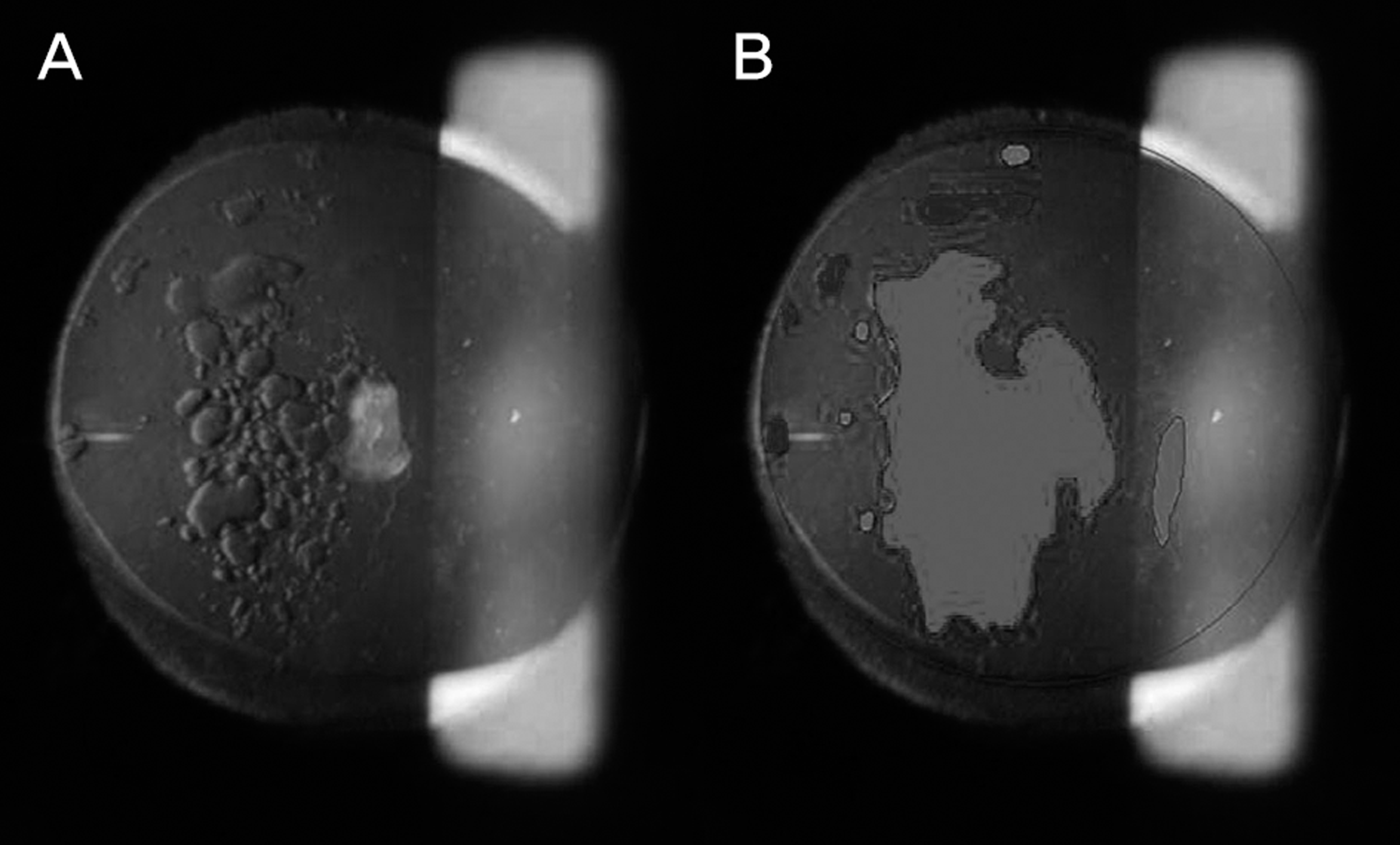Abstract
Purpose:
To evaluate posterior capsular opacity (PCO) using straylight and glare sensitivity meter and to compare availability of straylight and glare sensitivity with known methods for PCO evaluation.
Methods:
Thirty-six pseudophakic eyes with PCO were selected for this study. Best-corrected visual acuity (BCVA), straylight (C-quant, Oculus GmbH, Wetzlar, Germany) and glare sensitivity (Binoptometer, Oculus GmbH, Wetzlar, Germany) were meas-ured before mydriasis. After mydriasis, PCO images were captured with a slit-lamp and analyzed using the Evaluation of Posterior Capsular Opacification (EPCO) program (EPCO software, University of Heidelberg, Heidelberg, Germany). The same measurements were taken after capsulotomy and compared with pre-capsulotomy data.
Results:
After capsulotomy, BCVA, EPCO score and straylight were improved with statistical significance ( p < 0.05). Cases of PCO with mildly decreased visual acuity showed statistically significantly improved EPCO score and straylight ( p < 0.05). Glare sensitivity did not show significant improvement but was statistically significantly correlated with straylight ( p = 0.023, Rho = 0.732).
References
1. Pandey SK, Apple DJ, Werner L. . Posterior capsule opacifica-tion: a review of the aetiopathogenesis, experimental and clinical studies and factors for prevention. Indian J Ophthalmol. 2004; 52:99–112.
2. Cheng CY, Yen MY, Chen SJ. . Visual acuity and contrast sen-sitivity in different types of posterior capsule opacification. J Cataract Refract Surg. 2001; 27:1055–60.

3. van Bree MC, van den Berg TJ, Zijlmans BL. Posterior capsule opacification severity, assessed with straylight measurement, as main indicator of early visual function deterioration. Ophthalmology. 2013; 120:20–33.

4. van den Berg TJ. Introduction to retinal straylight. Netherlands Institute for Neuroscience. 2004; 1–11.
5. Michael R, van Rijn LJ, van den Berg TJ. . Association of lens, opacities, intraocular straylight, contrast sensitivity and visual acuity in European drivers. Acta Ophthalmol. 2009; 87:666–71.

6. Aslam TM, Haider D, Murray IJ. Principles of disability glare measurement: an ophthalmological perspective. Acta Ophthalmol Scand. 2007; 85:354–60.

7. Kang MJ, Hwang HB, Chung SK. Effect of glistening-free intra-ocular lens on intraocular straylight. J Korean Ophthalmol Soc. 2014; 55:1001–6.

8. Lee SY, Oh JH. Straylight in normal and cataractous eyes of Koreans. J Korean Ophthalmol Soc. 2011; 52:182–9.

9. Hiraoka T, Okamoto C, Ishii Y. . Mesopic contrast sensitivity and ocular higher-order aberrations after overnight orthokeratology. Am J Ophthalmol. 2008; 145:645–55.

10. Puell MC, Palomo C, Sánchez-Ramos C, Villena C. Mesopic con-trast sensitivity in the presence or absence of glare in a large driver population. Graefes Arch Clin Exp Ophthalmol. 2004; 242:755–61.

11. Findl O, Buehl W, Menapace R. . Comparison of 4 methods for quantifying posterior capsule opacification. J Cataract Refract Surg. 2003; 29:106–11.

12. Tetz MR, Auffarth GU, Sperker M. . Photographic image anal-ysis system of posterior capsule opacification. J Cataract Refract Surg. 1997; 23:1515–20.

13. Van Den Berg TJ, Van Rijn LJ, Michael R. . Straylight effects with aging and lens extraction. Am J Ophthalmol. 2007; 144:358–63.

14. Langeslag MJ, van der Mooren M, Beiko GH, Piers PA. Impact of intraocular lens material and design on light scatter: in vitro study. J Cataract Refract Surg. 2014; 40:2120–7.

15. Hirnschall N, Crnej A, Gangwani V, Findl O. Comparison of meth-ods to quantify posterior capsule opacification using forward and backward light scattering. J Cataract Refract Surg. 2014; 40:728–35.

16. Montenegro GA, Marvan P, Dexl A. . Posterior capsule opaci-fication assessment and factors that influence visual quality after posterior capsulotomy. Am J Ophthalmol. 2010; 150:248–53.

Figure 1.
Compensation method of C-quant and test field. (A) Stray light source on state. From outermost circle zone, projection of stray light source is scattered to the retina including fovea. (B) Stray light source off state. From innermost circle zone, compensa-tion light flickering is projected to fovea. (C) Real test field. Zone a is stray light source and zone b is compensation light source. * Outermost circle zone; † Innermost circle zone.

Figure 2.
Test field of glare sensitivity meter. (A) Light source off state. Randolt ring of resolution of 0.1 arc-minute is shown. (B) Light source on state. Brightness is increased and contrast is decreased due to glare light source.

Figure 3.
Image of posterior capsular opacity from slit-lamp camera (A) and analyzed image by Evaluation of Posterior Capsular Opacification (EPCO) software (B).

Figure 4.
Comparison of mean and 95% confidence interval (CI) of measurement in preYAG (Pre-YAG capsulotomy state) and postYAG (Post-YAG capsulotomy state) of total participants. (A) Best corrected visual acuity (BCVA) improved from 0.49 ± 0.25 to 0.77 ± 0.20. (B) Log(s) of stray light improved from 1.79 ± 0.62 to 1.45 ± 0.18. (C) Evaluation of Posterior Capsular Opacification (EPCO) score improved from 0.44 ± 0.48 to 0.04 ± 0.03. All measurements improved with statistical significance ( p = 0.001, p = 0.001, p = 0.018, respectively).

Figure 5.
Comparison of mean and 95% confidence interval (CI) of measurement in preYAG (Pre-YAG capsulotomy state) and postYAG (Post-YAG capsulotomy state) of participants whose pre-capsulotomy visual acuity was equal or better than 0.63. (A) Best corrected visual acuity (BCVA) are improved from 0.76 ± 0.13 to 0.86 ± 0.09 without statistical significance ( p = 0.061). (B) Log(s) of stray light improved from 1.57 ± 0.18 to 1.29 ± 0.04 and (C) Evaluation of Posterior Capsular Opacification (EPCO) score improved from 0.22 ± 0.12 to 0.04 ± 0.03. Both measurements showed statistically significant improvement ( p = 0.018, p = 0.043, respectively).

Figure 6.
(A) Comparison of glare sensitivity before and after capsulotomy. Glare sensitivity decreased from 0.055 ± 0.083 to 0.038 ± 0.052 without statistically significant improvement. (B) Statistical dispersion of glare sensitivity with stray light. It shows statistically significant correlation with stray light ( p = 0.023, Rho = 0.732). CI = confidence interval; PreYAG =Pre-YAG cap-sulotomy state; PostYAG =Post-YAG capsulotomy state.

Table 1.
Demographics and measured data
| No. of patients (eyes) | 36 |
| Age (years) | 66.7 ± 10.9 |
| Sex (Male:female) | 6:30 |
| Mean interval (months)∗ | 24.6 ± 15.1 |
| BCVA | |
| Pre-capsulotomy | 0.49 ± 0.25 |
| Post-capsulotomy ( p-value) | 0.77 ± 0.20 ( p < 0.001) |
| Log(s) of Straylight | |
| Pre-capsulotomy | 1.79 ± 0.62 |
| Post-capsulotomy ( p-value) | 1.45 ± 0.18 ( p = 0.001) |
| EPCO score | |
| Pre-capsulotomy | 0.44 ± 0.48 |
| Post-capsulotomy ( p-value) | 0.04 ± 0.03 ( p = 0.018) |
| Log CS of glare sensitivity | |
| Pre-capsulotomy | 0.055 ± 0.083 |
| Post-capsulotomy ( p-value) | 0.038 ± 0.052 ( p = 0.273) |




 PDF
PDF ePub
ePub Citation
Citation Print
Print


 XML Download
XML Download